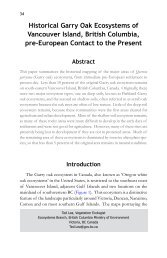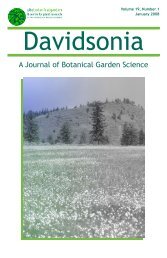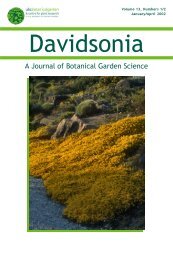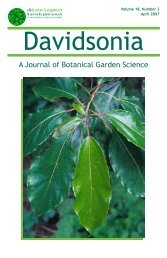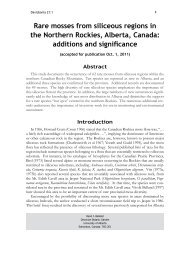pdf wkg Dav.14-14 - Davidsonia
pdf wkg Dav.14-14 - Davidsonia
pdf wkg Dav.14-14 - Davidsonia
Create successful ePaper yourself
Turn your PDF publications into a flip-book with our unique Google optimized e-Paper software.
<strong>Davidsonia</strong> <strong>14</strong>:4<br />
123<br />
ranges are affected at ultramafic sites in the state of Washington. Several<br />
tree and shrub species occur at higher and lower elevations on serpentine<br />
than their normal elevation ranges on non-serpentine soils (Kruckeberg 1969).<br />
Little information is available for the plant communities and vegetational<br />
responses to serpentine soils in British Columbia. There is some support<br />
for the hypothesis that the vegetational response to ultramafics is less<br />
pronounced with increasing latitude in western North America, a result of<br />
the increasing precipitation, the presence of non-ultramafic glacial till<br />
deposited ca 12,000 years ago, and the relatively short time available for<br />
speciation since glacial retreat (Whittaker 1954; Kruckeberg 1979, 1992; D.<br />
Lloyd, pers. comm.; R. Scagel, pers. comm.).<br />
This report is part of a larger study directed to characterize the extent of<br />
the serpentine effect and to expand the knowledge of floristics and ecology<br />
of ultramafic sites in British Columbia. Through a detailed comparison of<br />
adjacent ultramafic and non-ultramafic soils, we sought to understand the<br />
uniqueness of ultramafic sites within a British Columbia context in order to<br />
help inform the decisions of conservationists and land managers.<br />
Study Site<br />
We compared plant communities and associated soils at Grasshopper<br />
Mountain, part of the Tulameen ultramafic complex (49 o 20’ N, 120 o 50’ W)<br />
of southern British Columbia (Figure 8). This is a relatively flat-topped<br />
mountain (elevation <strong>14</strong>87 m) with a vertical rise of approximately 565 m. It<br />
is 6 km long and 2.5 km wide. Grasshopper Mountain was chosen because<br />
there were adjacent sections of ultramafic and non-ultramafic soils that<br />
minimized the confounding influences of aspect, topography, history, biota,<br />
and climate on the developing plant communities and permitted differences<br />
in vegetation to be directly attributed to edaphic factors.<br />
The Tulameen ultramafic complex lies within a climatic transition zone<br />
between humid coastal British Columbia and the dry interior. The complex<br />
is overlaid by coniferous forests dominated by Pseudostuga menziesii (Douglasfir),<br />
Pinus contorta var. latifolia (lodgepole pine), and P. ponderosa (ponderosa<br />
pine) at lower elevations, and by Pseudotsuga menziesii, Abies lasiocarpa (subalpine<br />
fir), and Picea engelmannii (Engelmann spruce) at higher elevations. Previous<br />
studies provide information on the geology (Cook and Fletcher 1993; Fletcher



